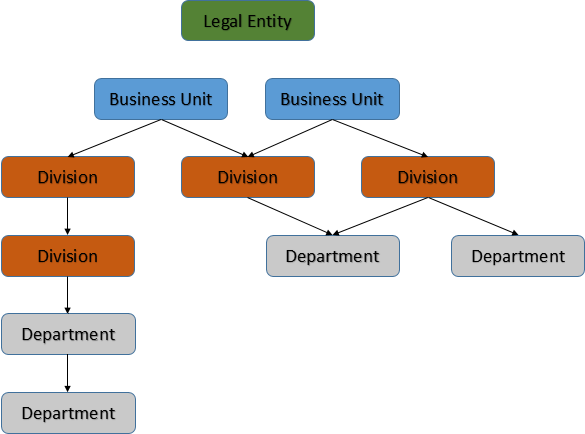SuccessFactors Employee Central Organization Structure represents the real-world hierarchy and divisions within a business. It is built using foundational elements like Legal Entities, Business Units, Divisions, Departments, Locations, and more. This flexible structure enables companies to organize, manage, and maintain employee and organizational data efficiently.
Here’s a simplified explanation of the key components and their purpose:
SuccessFactors Employee Central Organization Structure
In Employee Central, foundational objects store essential information about an organization and its employees. These objects can either reference organizational data or propagate values automatically into employee records, such as their job or compensation details. You can customize these objects and even add new ones as needed.
| Foundation Object | SAP ERP HCM equivalent |
|---|---|
| Legal Entity | Company Code |
| Business Unit | Business Area / Organizational Unit (Object type O) |
| Division | Organizational Unit (Object type O) |
| Department | Organizational Unit (Object type O) |
| Location | Personnel Area / Personnel Subarea |
| Cost Center | Cost Center (Object type K) |

Legal Entity
- Represents a company’s legal entity (often referred to as “Company”).
- Every employee must be assigned to a Legal Entity upon hire.
- Stores key details like country, default pay group, location, currency, and standard working hours.
- Country-specific fields allow for compliance with local regulations.
- Equivalent to the Company Code in SAP ERP HCM.
Business Unit
- Represents a segment of a Legal Entity focused on specific business functions like sales, marketing, or manufacturing.
- While there’s no direct equivalent in SAP ERP HCM, a Business Unit could resemble the Business Area or an Organizational Unit.
Division
- A subdivision of a Business Unit, used for further segmentation.
- Can also represent a division directly under a Legal Entity, showcasing Employee Central’s flexibility.
- Equivalent to an Organizational Unit in SAP ERP HCM.
Department
- Represents the functional areas within a Division.
- Typically, this is the lowest unit in the organization structure hierarchy.
- Most closely resembles an Organizational Unit in SAP ERP HCM.
Location
- Represents the physical location of employees, such as an office or factory.
- Defines the time zone and standard working hours of the employee.
- Equivalent to the Personnel Subarea in SAP ERP HCM.
Cost Center
- Represents units that track and manage business costs.
- Often used to assign costs related to an employee’s work.
- Cost Centers can form a hierarchy by assigning parent Cost Centers.
- Functions like the Cost Center in SAP ERP HCM.
Generic Objects
- Custom objects created using the Metadata Framework (MDF).
- Useful for adding additional layers to the organization structure (e.g., project teams or certifications).
- Highly customizable and ideal for unique business needs.
2. Associations Between Objects
In Employee Central, associations define relationships between organizational elements. These relationships create a parent-child hierarchy and ensure consistent filtering of data.
Types of Associations:
- One-to-One: A single object is linked to one parent (e.g., a Department linked to one Division).
- One-to-Many: A single object is linked to multiple children (e.g., a Division associated with multiple Departments).
Example: A Manufacturing Company’s Structure
- Legal Entity: The company is divided into three Business Units:
- Plastics
- Metals
- Woods
- Each Business Unit has multiple Divisions:
- Plastics: R&D, Manufacturing, Distribution
- Metals: Metalworks, Alloys
- Woods: Carpentry, Timber
- Departments fall under these Divisions.
When an administrator hires a new employee, they:
- Select the Legal Entity.
- Choose a Business Unit (e.g., Plastics).
- See filtered Division options (e.g., R&D, Manufacturing, or Distribution).
- Select the relevant Division and Department.
3. Jobs and Positions
- Job Classifications:
- Contain details about the employee’s job role.
- Attributes include job title, pay grade, weekly hours, and employment type (full-time or part-time).
- Job Classifications often propagate key information to employee records.
- Positions:
- Define specific roles an employee occupies.
- Can have parent positions to create a Position-based organizational chart.
- Unlike SAP ERP HCM, Positions are not mandatory in Employee Central.
4. Propagation in Employee Central
Propagation automates data entry:
- For example, selecting a Location can auto-fill details like Legal Entity, Business Unit, and Time Zone in the employee’s records.
- This reduces manual errors and ensures data consistency.
5. Key Benefits of Employee Central’s Flexibility
- Customizable Organization Structure: Businesses can create structures that mirror their real-world operations.
- Hierarchy Maintenance: Associations ensure clear relationships between organizational elements.
- Streamlined Onboarding: Propagation makes hiring processes faster and more accurate.
- Data Consistency: Automatic propagation ensures that employee data aligns with organizational rules.
Summary
The organization structure in SuccessFactors Employee Central provides unmatched flexibility and granularity compared to traditional systems like SAP ERP HCM. It allows organizations to replicate their real-world hierarchy accurately, ensuring smoother operations and better data management. By leveraging foundational objects, propagation rules, and custom Generic Objects, businesses can design an enterprise structure that aligns with their goals and workflows.
